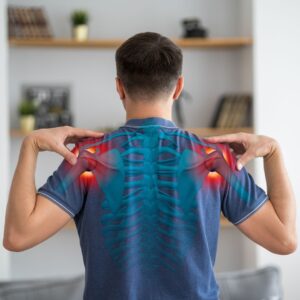What Causes Shoulder Impingement?
Shoulder impingement syndrome is one of the most common causes of shoulder pain, affecting millions of people worldwide. This condition occurs when the rotator cuff tendons become irritated and inflamed as they pass through the narrow space between the acromion (the bony prominence at the top of the shoulder blade) and the head of the humerus (upper arm bone). Understanding the causes of shoulder impingement is crucial for proper diagnosis, treatment, and prevention.
Anatomy of the Shoulder 
To comprehend shoulder impingement, it’s essential to understand the anatomy of the shoulder joint. The shoulder is a complex structure consisting of:
- The humerus (upper arm bone)
- The scapula (shoulder blade)
- The clavicle (collarbone)
- The rotator cuff muscles and tendons
- The bursa (a fluid-filled sac that reduces friction)
The rotator cuff is a group of four muscles and their tendons that surround the shoulder joint, providing stability and enabling a wide range of motion. These muscles are the supraspinatus, infraspinatus, teres minor, and subscapularis.
Types of Shoulder Impingement
There are two main types of shoulder impingement:
- Primary (Structural) Impingement: This occurs due to anatomical abnormalities or changes in the shoulder structure.
- Secondary (Functional) Impingement: This results from altered shoulder mechanics or muscle imbalances.
Causes of Shoulder Impingement
Several factors can contribute to the development of shoulder impingement syndrome:
1. Anatomical Factors
- Bone spurs: The formation of bony projections on the acromion can narrow the subacromial space, leading to impingement.
- Acromion shape: A hooked or curved acromion can increase the risk of impingement.
- Critical shoulder angle: A larger angle between the glenoid and acromion can predispose individuals to impingement.
2. Rotator Cuff Weakness or Imbalance
Weakness or imbalance in the rotator cuff muscles can alter shoulder mechanics, causing the humeral head to shift upward and compress the subacromial space.
3. Poor Posture
Prolonged poor posture, especially rounded shoulders and forward head position, can contribute to shoulder impingement by altering scapular positioning and muscle function.
4. Repetitive Overhead Activities
Occupations or sports that involve frequent overhead motions (e.g., painting, swimming, tennis) can lead to rotator cuff tendinitis and subsequent impingement.
5. Age-Related Degeneration
As we age, the tendons of the rotator cuff naturally degenerate, becoming less flexible and more prone to irritation and inflammation.
6. Previous Shoulder Injuries
A history of shoulder dislocations or other injuries can increase the likelihood of developing impingement syndrome.
7. Shoulder Instability
Excessive laxity in the shoulder joint can cause the humeral head to move abnormally, potentially leading to impingement.
 Symptoms of Shoulder Impingement
Symptoms of Shoulder Impingement
Common symptoms of shoulder impingement include:
- Pain when raising the arm, especially between 60 and 120 degrees
- Weakness in the shoulder and arm
- Difficulty reaching behind the back
- Pain that worsens at night, particularly when lying on the affected side
- A catching or grinding sensation during shoulder movement
Diagnosis of Shoulder Impingement
Diagnosing shoulder impingement typically involves:
1. Physical examination: The doctor will assess range of motion, strength, and perform specific tests like the Neer’s sign and Hawkins-Kennedy test.
2. Imaging studies:
– X-rays to evaluate bone structure and detect any spurs
– MRI or ultrasound to visualize soft tissues and assess the condition of the rotator cuff tendons
3. Diagnostic injections: A subacromial injection of local anesthetic can help confirm the diagnosis if it provides temporary pain relief.
Treatment Options for Shoulder Impingement
Treatment for shoulder impingement usually begins with conservative measures:
Conservative Treatment
- Rest and activity modification
- Ice or heat therapy
- Nonsteroidal anti-inflammatory drugs (NSAIDs)
- Physical therapy to improve shoulder mechanics and strengthen the rotator cuff
- Corticosteroid injections for short-term pain relief
Surgical Intervention
If conservative treatments fail to provide relief after several months, surgery may be considered. Surgical options include:
- Arthroscopic subacromial decompression: Removing bone spurs and inflamed tissue to create more space for the rotator cuff.
- Rotator cuff repair: If a tear is present, it may be surgically repaired.
Prevention of Shoulder Impingement
To reduce the risk of developing shoulder impingement:
- Maintain good posture
- Perform regular shoulder strengthening exercises
- Use proper technique during overhead activities
- Take breaks and avoid prolonged repetitive overhead motions
- Gradually increase the intensity of shoulder exercises or activities
Contact Us
Shoulder impingement is a common and often treatable condition. Understanding its causes is crucial for proper management and prevention. By addressing factors such as anatomical abnormalities, muscle imbalances, and poor posture, many cases of shoulder impingement can be effectively treated without surgery. However, for persistent or severe cases, surgical intervention may be necessary to restore shoulder function and alleviate pain. If you’re experiencing symptoms of shoulder impingement, consult with an orthopedic specialist at Dines Orthopedics for a comprehensive evaluation and personalized treatment plan.

